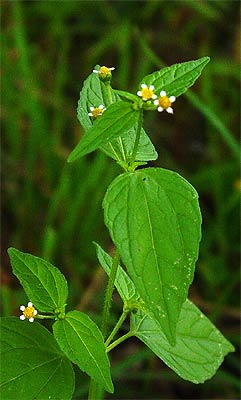Galinsoga is known to have been growing in the Bartram botanical garden in Philadelphia in 1836, and the earliest recorded naturalized populations in the U.S. were not far from Philadelphia, in Baltimore, eastern Pennsylvania, and New York, suggesting that it may have escaped from there. Alternatively, there may have been multiple independent introductions from abroad. The plant may be spread about by several means—the small, lightweight "seeds" (technically fruits) can be blown short distances by the wind, and are covered with short stiff hairs which help them cling to the fur of animals or the clothing of humans. They can also be transported in soil. Early records of the species in the U.S. were concentrated in and around cities, while for a time the plant remained relatively rare in rural areas, suggesting that long distance dispersal was accomplished mostly through the activities of humans, as an inadvertent consequence of travel and commerce.
In New England, Galinsoga was at first found in scattered localities. By 1866 it had arrived in New Hampshire, but the first record of its presence in Massachusetts was not until 1891, by Fernald in Cambridge. In 1900 it was seen growing by railroad tracks in Dedham, and its observer noted that it was becoming "more commonly found" in 1908 it was "growing freely" by the Church Street entrance to the subway in Boston.
 Galinsoga
Galinsoga